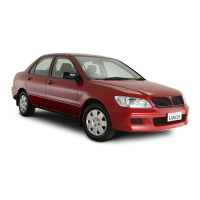MPI – Troubleshooting
Vehicle
speed
Initial accel-
erator pedal
depression
Normal
Hesitation
Sag
Time
(Figure 1)
(Figure 2)
Normal
Initial accel-
erator pedal
depression
Idling
Stumble
Time
Vehicle
speed
13-19
PROBLEM SYMPTOMS TABLE (FOR YOUR INFORMATION)
Items Symptom
Starting Won’t start The starter is used to crank the engine, but there is no combustion within the
cylinders, and the engine won’t start.
Fires up and dies There is combustion within the cylinders, but then the engine soon stalls.
Hard starting Engine starts after cranking a while.
Idling
Hunting Engine speed doesn’t remain constant; changes at idle.
s
a
y
Rough idle Usually, a judgement can be based upon the movement of the tachometer
pointer, and the vibration transmitted to the steering wheel, shift lever, body, etc.
This is called rough idle.
Incorrect idle speed The engine doesn’t idle at the usual correct speed.
Engine stall
(Die out)
The engine stalls when the foot is taken from the accelerator pedal, regardless
of whether the vehicles is moving or not.
Engine stall
(Pass out)
The engine stalls when the accelerator pedal is depressed or while it is being
used.
Driving Hesitation, Sag “Hesitation” is the delay in response of the vehicle speed (engine speed) that
occurs when the accelerator is depressed in order to accelerate from the speed
at which the vehicle is now traveling, or a temporary drop in vehicle speed
(engine speed) during such acceleration. Serious hesitation is called “sag”.
(Refer to Figure 1.)
Poor acceleration Poor acceleration is inability to obtain an acceleration corresponding to the
degree of throttle opening, even though acceleration is smooth, or the inability
to reach maximum speed.
Stumble Engine speed increase is delayed when the accelerator pedal is initially
depressed for acceleration. (Refer to Figure 2.)
Shock The feeling of a comparatively large impact or vibration when the engine is
accelerated or decelerated.
Surge This is repeated surging ahead during constant speed travel or during variable
speed travel.
Knocking A sharp sound like a hammer striking the cylinder walls during driving and which
adversely affects driving.
Stopping Run on
(“Dieseling”)
The condition in which the engine continues to run after the ignition switch is
turned to OFF. Also called “Dieseling”.

